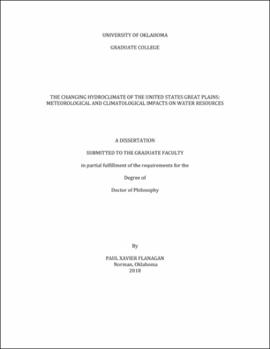| dc.description.abstract | In the United States Great Plains (GP), understanding precipitation variability is key in developing an understanding of the present and future availability of water in the region. Numerous studies have investigated the hydroclimate, or the part of the climate relating to the hydrology of a region, of the GP from the soils, surface, vegetation and their impacts on water resources. Even so, there is still more to be understood from a climatological perspective. Further, analysis of the GP climate in terms of temperature and precipitation maxima in relation to the hydroclimate is not yet complete. While drought and its associated drivers have been studied in the GP region, periods of excessive precipitation (pluvials) at seasonal to interannual scales have received less attention. Thus, analysis of the GP climate in terms of features that directly impact water is required to more fully understand the GP climate and future impacts to water availability.
The first part of this study investigated a long-term observational dataset to quantify the asynchronicity and address the impacts of climate variability and change. Global Historical Climate Network Daily (GHCN-Daily) data were utilized for this study; 352 GHCN-Daily stations were identified based on specific criteria and the dates of the precipitation and temperature maxima for each year were identified at daily and weekly intervals. An Asynchronous Difference Index (ADI) was computed by determining the difference between these dates averaged over each decade. Analysis of Daily and Weekly ADI revealed two physically distinct regimes of ADI (positive and negative), with comparable shifts in the timing of both the maximum of precipitation and temperature over all six states within the GP examined when comparing the two different regimes. Time series analysis of decadal average ADI yielded moderate shifts (~5-10 days from linear regression analysis) in ADI in several states with increased variability occurring over much of the study region.
Utilizing the ERA-20C dataset, a climatological analysis of GP pluvials was completed. Through an analysis of GP precipitation, the region was split into two subregions; the Northern Great Plains (NGP) and the Southern Great Plains (SGP). Analysis of ERA-20C geopotential heights during NGP and SGP pluvial years reveals atmospheric anomaly patterns associated with the occurrence of pluvial years. In the SGP, this pattern is depicted by negative height anomalies over the southwestern United States, coincident with a southward shifted jet stream over the north Pacific allowing a more frequent passage of synoptic waves toward the southern United States. The NGP pluvial pattern shows negative height anomalies over the northwestern United States and an anomalously extended jet stream over the northern North Pacific. Further, analysis of sea surface temperatures (SST) and streamfunction aids in explaining the occurrence of these pluvial years. During SGP above average precipitation (i.e., pluvial) years, central tropical Pacific SST anomalies occur concurrently with key atmospheric anomalies across the Pacific basin and North America and they contribute significantly to the occurrence of excessive rainfall, with no specific pattern of oceanic or atmospheric anomalies emergin during NGP pluvial years. When comparing the SGP pluvial of 2015 to that of 2007, differences in the height, SST and streamfunction anomaly fields described the overall differences between pluvial years driven by annual atmospheric anomalies and years which show no strong atmospheric annual anomaly feature associated with annual excessive precipitation. Overall, the results from this study reveal new insights to precipitation variability across the GP owing to local and global processes. | en_US |
